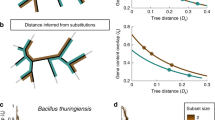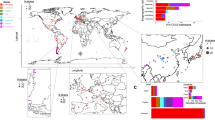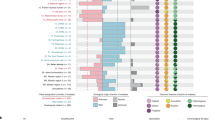Abstract
Gene duplication is an important source of evolutionary novelty1,2. Most duplications are of just a single gene, but Ohno1 proposed that whole-genome duplication (polyploidy) is an important evolutionary mechanism. Many duplicate genes have been found in Saccharomyces cerevisiae, and these often seem to be phenotypically redundant3,4,5,6,7. Here we show that the arrangement of duplicated genes in the S. cerevisiae genome is consistent with Ohno's hypothesis. We propose a model in which this species is a degenerate tetraploid resulting from a whole-genome duplication that occurred after the divergence of Saccharomyces from Kluyveromyces. Only a small fraction of the genes were subsequently retained in duplicate (most were deleted), and gene order was rearranged by many reciprocal translocations between chromosomes. Protein pairs derived from this duplication event make up 13% of all yeast proteins, and include pairs of transcription factors, protein kinases, myosins, cyclins and pheromones. Tetraploidy may have facilitated the evolution of anaerobic fermentation in Saccharomyces.
This is a preview of subscription content, access via your institution
Access options
Subscribe to this journal
Receive 51 print issues and online access
$199.00 per year
only $3.90 per issue
Buy this article
- Purchase on Springer Link
- Instant access to full article PDF
Prices may be subject to local taxes which are calculated during checkout



Similar content being viewed by others
References
Ohno, S. Evolution by Gene Duplication (George Allen and Unwin, London, 1970).
Hughes, A. L. The evolution of functionally novel proteins after gene duplication. Proc. R. Soc. Lond. B 256, 119–124 (1994).
Kaback, D. B. Yeast genome structure.In The Yeasts Vol. 6(eds Wheals, A. E., Rose, A. H. & Harrison, J. S.) 179–222 (Academic, London, 1995).
Olson, M. V. in The Molecular and Cellular Biology of the Yeast Saccharomyces Vol. 1(eds Broach, J. R., Pringle, J. R. & Jones, E. W.) 1–40 (Cold Spring Harbor Laboratory Press, NY, 1991).
Smith, M. M. Molecular evolution of the Saccharomyces cerevisiae histone gene loci. J. Mol. Evol. 24, 252–259 (1987).
Lalo, D., Stettler, S., Mariotte, S., Slonimski, P. P. & Thuriaux, P. Une duplication fossile entre les régions centromériques de deux chromosomes chez la levure. C.R. Acad. Sci. 316, 367–373 (1993).
Melnick, L. & Sherman, F. The gene clusters ARC and COR on chromosomes 5 and 10, respectively, of Saccharomyces cerevisiae share a common ancestry. J. Mol. Biol. 233, 372–388 (1993).
Goffeau, A.et al. Life with 6000 genes. Science 274, 546–567 (1996).
Altschul, S. F., Gish, W., Miller, W., Myers, E. W. & Lipman, D. J. Basic local alignment search tool. J. Mol. Biol. 215, 403–410 (1990).
Ahn, S. & Tanksley, S. D. Comparative linkage maps of the rice and maize genomes. Proc. Natl Acad. Sci. USA 90, 7980–7984 (1993).
Spring, J. Vertebrate evolution by interspecific hybridisation–are we polyploid? FEBS Lett. 400, 2–8 (1997).
Roman, H. & Sands, S. M. Heterogeneity of clones of Saccharomyces derived from haploid ascospores. Proc. Natl Acad. Sci. USA 39, 171–179 (1953).
Kielland-Brandt, M. C., Nilsson-Tillgren, T., Gjermansen, C., Holmberg, S. & Pedersen, M. B. Genetics of brewing yeasts.In The Yeasts Vol. 6(eds Wheals, A. E., Rose, A. H. & Harrison, J. S.) 223–254 (Academic, London, 1995).
Ryu, S.-L., Murooka, Y. & Kaneko, Y. Genomic reorganization between two sibling yeast species, Saccharomyces bayanus and Saccharomyces cerevisiae. Yeast 12, 757–764 (1996).
Hendriks, L.et al. Phylogenetic relationships among ascomycetes and ascomycete-like yeasts as deduced from small subunit ribosomal subunit RNA sequences. Syst. Appl. Microbiol. 15, 98–104 (1992).
Heus, J. J., Zonneveld, B. J. M., Steensma, H. Y. & van den Berg, J. A. The consensus sequence of Kluyveromyces lactis centromeres shows homology to functional centromeric DNA from Saccharomyces cerevisiae. Mol. Gen. Genet. 236, 355–362 (1993).
Stark, M. J. R. & Milner, J. S. Cloning and analysis of the Kluyveromyces lactis TRP1 gene: a chromosomal locus flanked by genes encoding inorganic pyrophosphatase and histone H3. Yeast 5, 35–50 (1989).
Larson, G. P., Castanotto, D., Rossi, J. J. & Malafa, M. P. Isolation and functional analysis of a Kluyveromyces lactis RAP1 homologue. Gene 150, 35–41 (1994).
Bergkamp-Steffens, G. K., Hoekstra, R. & Planta, R. J. Structural and putative regulatory sequences of Kluyveromyces ribosomal protein genes. Yeast 8, 903–922 (1992).
Hurwitz, N., Segal, M., Marbach, I. & Levitzki, A. Differential activation of yeast adenylyl cyclase by Ras1 and Ras2 depends on the conserved N terminus. Proc. Natl Acad. Sci. USA 92, 11009–11013 (1995).
Dohrmann, P. R.et al. Parallel pathways of gene regulation: homologous regulators SWI5 and ACE2 differentially control transcription of HO and chitinase. Genes Dev. 6, 93–104 (1992).
Schmidt, A., Kunz, J. & Hall, M. N. TOR2 is required for organization of the actin cytoskeleton in yeast. Proc. Natl Acad. Sci. USA 93, 13780–13785 (1996).
Jansen, R. P., Dowzer, C., Michaelis, C., Galova, M. & Nasmyth, K. Mother cell-specific HO expression in budding yeast depends on the unconventional myosin Myo4p and other cytoplasmic proteins. Cell 84, 687–697 (1996).
Friis, E. M., Chaloner, W. G. & Crane, P. R. (eds) The Origins of Angiosperms and their Biological Consequences (Cambridge Univ. Press, 1987).
Fitch, W. M. & Margoliash, E. Construction of phylogenetic trees. Science 155, 279–284 (1967).
Acknowledgements
We thank our colleagues in the yeast genome project; J. I. Garrels for use of the YPD database, which was central to this study; G. Butler, A. T. Lloyd, L. Skrabanek, C. Seoighe, B. Baum and R.Rothstein for comments; and S. Kossida, M. Lewis and R. Keogh for initial work on this project. Yeast genome sequencing in our laboratory was supported by the European Union. In silico analysis is supported by the European Union and Forbairt (to K.H.W.) and the Wellcome Trust (to D.C.S.).
Author information
Authors and Affiliations
Corresponding author
Rights and permissions
About this article
Cite this article
Wolfe, K., Shields, D. Molecular evidence for an ancient duplication of the entire yeast genome. Nature 387, 708–713 (1997). https://doi.org/10.1038/42711
Received:
Accepted:
Issue Date:
DOI: https://doi.org/10.1038/42711
This article is cited by
-
Unifying duplication episode clustering and gene-species mapping inference
Algorithms for Molecular Biology (2024)
-
POInTbrowse: orthology prediction and synteny exploration for paleopolyploid genomes
BMC Bioinformatics (2023)
-
Multiple intermolecular interactions facilitate rapid evolution of essential genes
Nature Ecology & Evolution (2023)
-
Origin and Evolution of RAS Membrane Targeting
Oncogene (2023)
-
Transcriptional activation of budding yeast DDI2/3 through chemical modifications of Fzf1
Cell Biology and Toxicology (2023)
Comments
By submitting a comment you agree to abide by our Terms and Community Guidelines. If you find something abusive or that does not comply with our terms or guidelines please flag it as inappropriate.



